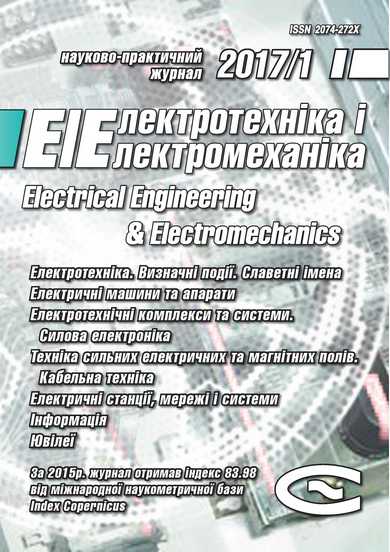EXPERIMENTAL RESEARCH OF MAGNETIC FIELD SENSORS SPATIAL ARRANGEMENT INFLUENCE ON EFFICIENCY OF CLOSED LOOP OF ACTIVE SCREENING SYSTEM OF MAGNETIC FIELD OF POWER LINE
DOI:
https://doi.org/10.20998/2074-272X.2017.1.03Keywords:
power frequency magnetic field, high voltage power lines model, active screening system model, experimental researchAbstract
Purpose. Experimental research of magnetic field sensors spatial arrangement influence on efficiency of closed loop active screening system by magnetic field of high voltage power lines developed a three-phase single-circuit high voltage power lines, creating a rotating magnetic field with the most complex space-time structure. Methodology. Optimal spatial arrangement of the magnetic field sensors is determined by solving the active magnetic field screening system synthesis problems with which the system provides the greatest efficiency of the active magnetic field shielding. Synthesis of active screening system is reduced to the problem of multi-criteria nonlinear programming with constraints in which calculation of the objective functions and constraints are carried out on the basis of Biot-Savart-Laplace law. The problem is solved by a stochastic multi-agent optimization by multiswarm of particles which can significantly reduce the time to solve it. Calculated arrangement of magnetic field sensors in a given space defined by the points at which the values of the corresponding components of the vector of magnetic induction take minimal values. Results. For the first time experimentally that changes in the position of the magnetic field sensors relative to their calculated position reduces the effectiveness of screening. The optimum position of the magnetic field sensors are the points at which the levels of the magnetic induction vector of projections orthogonal to the planes of the compensating coils are minimum values. Originality. For the first time invited to place sensors closed loop active screening system by magnetic field of high voltage power lines at the points where the calculated levels of corresponding projections of the magnetic induction vector orthogonal planes compensating windings are minimum values. Practical value. Practical recommendations for evidence-based selection of the spatial arrangement of the magnetic field sensors in a given area to ensure maximum efficiency of the active magnetic field screening system.References
1. Pravila ulashtuvannya electroustanovok. Vyd. 3, pererob. i dop [Electrical Installation Regulations. 3rd edition, revised and enlarged]. Kyiv, Мinpalyvenergo of Ukraine Publ., 2010. 736 p. (Ukr).
2. Active Magnetic Shielding (Field Cancellation). Available at: http://www.emfservices.com/afcs.html (accessed 10 September 2012).
3. Beltran H., Fuster V., García M. Magnetic field reduction screening system for a magnetic field source used in industrial applications. 9 Congreso Hispano Luso de Ingeniería Eléctrica (9 CHLIE), Marbella (Málaga, Spain), 2005, pр. 84-99.
4. Celozzi S., Garzia F. Active shielding for power-frequency magnetic field reduction using genetic algorithms optimization. IEE Proceedings – Science, Measurement and Technology, 2004, Vol.151, no.1, pp. 2-7. doi: 10.1049/ip-smt:20040002.
5. Ter Brake H.J.M., Wieringa H.J., Rogalla H. Improvement of the performance of a mu -metal magnetically shielded room by means of active compensation (biomagnetic applications). Measurement Science and Technology, 1991, Vol.2(7), pp. 596-601. doi: 10.1088/0957-0233/2/7/004.
6. Yamazaki K., Kato K., Kobayashi K. MCG Measurement in the environment of active magnetic shield. Neurology and Clinical Neurophysiology, 2004, Vol. 40, pp. 1-4.
7. Celozzi S. Active compensation and partial shields for the power-frequency magnetic field reduction. Conference Paper of IEEE International Symposium on Electromagnetic Compatibility. Minneapolis (USA), 2002, Vol.1, pp. 222-226. doi: 10.1109/isemc.2002.1032478.
8. Shenkman A., Sonkin N., Kamensky V. Active protection from electromagnetic field hazards of a high voltage power line. HAIT Journal of Science and Engineering. Series B: Applied Sciences and Engineering, Vol. 2, Issues 1-2, pp. 254-265.
9. Ter Brake H.J.M., Huonker R., Rogalla H. New results in active noise compensation for magnetically shielded rooms. Measurement Science and Technology, 1993, Vol. 4, Issue 12, pp. 1370-1375. doi: 10.1088/0957-0233/4/12/010.
10. Kazuo Kato, Keita Yamazaki, Tomoya Sato, Akira Haga, Takashi Okitsu, Kazuhiro Muramatsu, Tomoaki Ueda, Masahito Yoshizawa. Shielding effect of panel type active magnetic compensation. IEEJ Transactions on Fundamentals and Materials, 2005, Vol. 125, Issue 2, pp. 99-106. doi: 10.1541/ieejfms.125.99.
11. Rozov V.Yu., Reutskyi S.Yu. Pyliugina O.Yu. The method of calculation of the magnetic field of three-phase power lines. Tekhnichna elektrodynamika, 2014, no.5, pp. 11-13. (Rus).
12. Nikolova N.K., Bakr M.H. Electromagnetics I. Matlab Experiments Manual for EE2FH3. Department of Electrical and Computer Engineering McMaster University, 2012. 96 р.
13. Clerc M. Particle Swarm Optimization. London, ISTE Ltd., 2006. 244 p. doi: 10.1002/9780470612163.
14. Gazi V., Passino K.M. Swarm Stability and Optimization. Springer, 2011. 318 p. doi: 10.1007/978-3-642-18041-5.
Downloads
Published
How to Cite
Issue
Section
License
Copyright (c) 2017 B. I. Kuznetsov, T. B. Nikitina, A. V. Voloshko, I. V. Bovdyj, E. V. Vinichenko, B. B. Kobilyanskiy

This work is licensed under a Creative Commons Attribution-NonCommercial 4.0 International License.
Authors who publish with this journal agree to the following terms:
1. Authors retain copyright and grant the journal right of first publication with the work simultaneously licensed under a Creative Commons Attribution License that allows others to share the work with an acknowledgement of the work's authorship and initial publication in this journal.
2. Authors are able to enter into separate, additional contractual arrangements for the non-exclusive distribution of the journal's published version of the work (e.g., post it to an institutional repository or publish it in a book), with an acknowledgement of its initial publication in this journal.
3. Authors are permitted and encouraged to post their work online (e.g., in institutional repositories or on their website) prior to and during the submission process, as it can lead to productive exchanges, as well as earlier and greater citation of published work.





